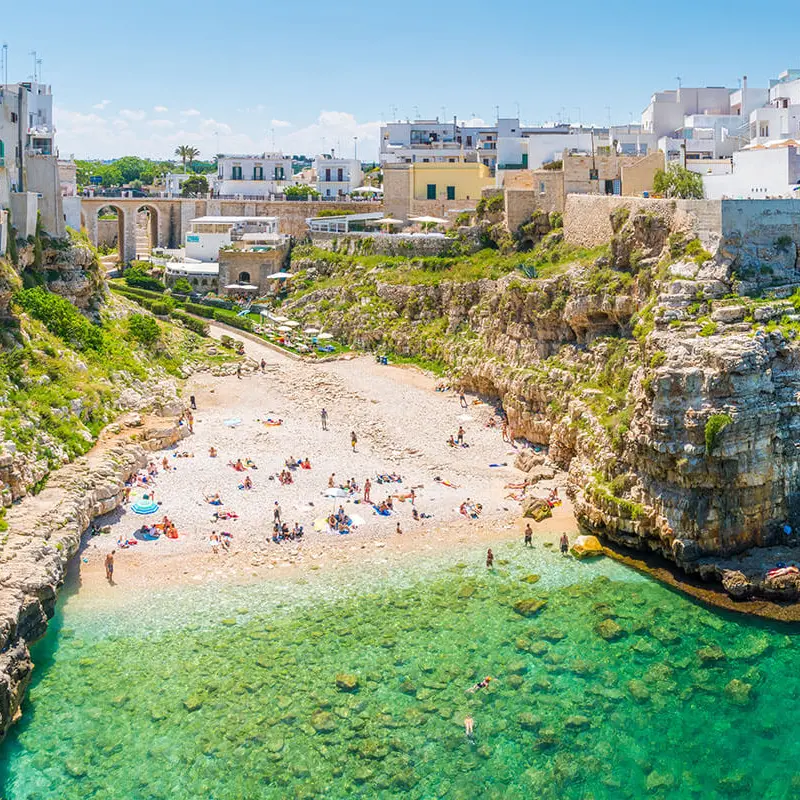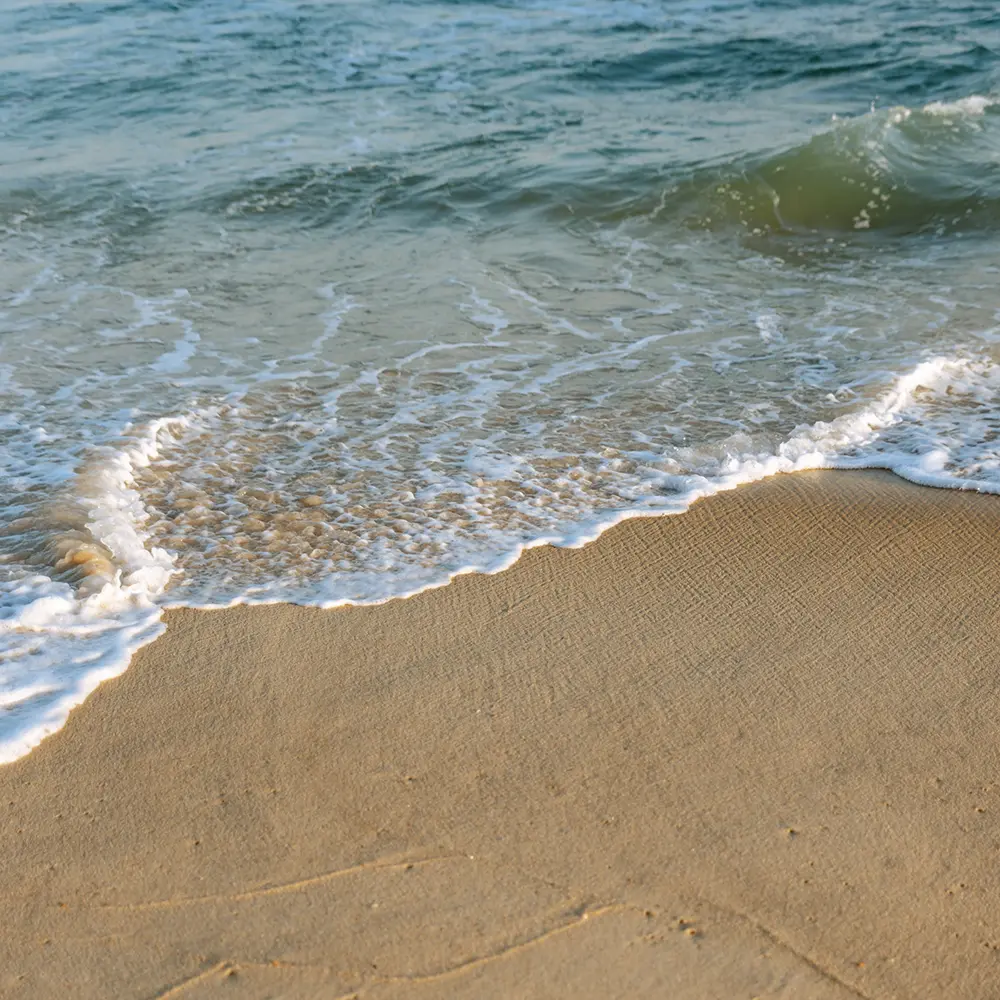
Noci, the city of gastronomy
10 minutes by car

Nestled among the green hills of Puglia, Noci is a unique tourist destination, enchanting visitors with its authenticity, cultural heritage and, above all, exceptional gastronomy.
Noci is famous for being a true oasis for lovers of good food and wine. Here, traditional cuisine is an art form, where the authentic flavors of local products blend to create unique and unforgettable dishes. First and foremost, the dairy tradition, which in Noci finds its fullest expression in the mozzarella made from traditional cow's milk, fresh cheeses, fresh and aged caciocavallo cheeses, and treccioni of stretched pasta. And then the meat, which in Noci, as in many towns in the Valle d'Itria, is still cooked in the "fornello" and the homemade white bread, famous throughout the region.
In addition to gastronomy, Noci also offers splendid opportunities for lovers of nature and hiking. The surrounding hills are ideal for pleasant walks or bike rides, allowing you to admire breathtaking landscapes and discover ancient trulli and farmhouses scattered throughout the countryside.
But even a walk through the streets of its historic center is an unforgettable experience. The maze of alleyways and gnostre, from the Latin "claustrum", literally "closed place", winds its way between white houses with stone roofs, adorned with graceful flowered balconies. It is a real pleasure to get lost in these picturesque streets, discovering hidden corners and breathtaking views.
In the magical world of the trulli in Alberobello
20 minutes by car

Alberobello is famous for its trulli, conical stone structures that have been designated a World Heritage Site by UNESCO in 1996.
The trulli were built in the Middle Ages by the farmers of the area, who were looking for an economical and easy way to build their homes. The stones were gathered from the surrounding area and put together without the use of cement or mortar, so that the houses could be easily dismantled and transported if necessary. The trulli are now inhabited by about 10,000 people and are one of the main tourist attractions in Puglia. The historic center of Alberobello is divided into two districts: Rione Monti and Rione Aia Piccola. Rione Monti is the oldest district and houses most of the trulli. Rione Aia Piccola is a more recent district and houses smaller and less traditional trulli.
Alberobello is a fascinating and unique city that offers visitors an unforgettable experience. Its cobblestone streets, its white trulli, and its medieval historic center create a magical atmosphere that is found nowhere else in the world. Rione Monti is the beating heart of Alberobello, and has been awarded the prestigious UNESCO World Heritage Site title for its architectural and historical uniqueness. More than a thousand cones stand in this district, along with the fifteen picturesque streets that cross it, creating a fascinating crossroads for thousands of tourists who visit it every year, in every season. Here you will find fascinating businesses that, at times, will offer you the opportunity to enter and visit the trulli in which they operate.
Each trullo has a fascinating story and the locals will be happy to tell you about it. You can immerse yourself in a magical past and discover the strong, centuries-old bond that unites these dwellings to the earth.
The Trullo Sovrano, an iconic monument of Alberobello, represents the pinnacle of the constructive skill of the master trullari, with its imposing dimensions and two floors, unique in the city. Over time, it has had several functions, from home to apothecary, to chapel for the relics of Saints Cosma and Damian. Today, it is a museum that hosts exhibitions, giving you an extraordinary cultural experience.
The Siamese Trulli, as the name suggests, are joined together since their origins, with their cones connected continuously in the lower part, a rare feature to find. The legend of the two brothers will intrigue you as you visit these particular dwellings.
In Rione Aia Piccola, you can admire the courtyards, such as the suggestive Corte di Giangiacomo e Pozzo Contino, enchanting courtyards surrounded by walls with houses overlooking them. Here, the pure essence of Alberobello remains uncontaminated, creating an urban oasis of relaxation, and the trulli can be admired in their original state, giving suggestive glimpses for photography lovers.
You will also discover several churches located in various parts of the town, including the Basilica of the Saints Cosma and Damian, the Church of Santa Lucia, the Church of the Carmine and the Church of Sant'Antonio, with its wonderful trullo architecture.
Your visit to Alberobello would not be complete without a gastronomic adventure, savoring the variety of vegetables, meats, fish, and cheeses typical of the local tradition.
Locorotondo, one of the most beautiful villages in Italy in the heart of the Valle d'Itria
25 minutes by car

Without a doubt, Locorotondo is one of the authentic pearls of the stunning Valle d'Itria, a must-see stop for an unforgettable tour of Puglia.
The name of the town comes from the shape of its charming historic center, located on top of a hill at 412 meters above sea level. Just as the name suggests, "Round Place," its medieval village has a circular shape, developing around the year 1000 around the majestic Mother Church.
The picturesque white houses shine like gems when the sun illuminates them, and the narrow streets wind their way between palaces and the characteristic residential dwellings, known as "cummerse." These dwellings, with multiple floors connected by steep internal staircases and with sloping roofs that skillfully channel rainwater to side gutters, seem to have been built even before the famous trulli typical of the area.
The care and attention of its inhabitants for cleanliness and order in the medieval village of Locorotondo will not go unnoticed. The splendid balconies adorned with floral and vegetable arrangements seem to be an indispensable pastime for residents, who during the Christmas season decorate the streets and facades of the houses with elegant decorations.
Getting lost among the suggestive streets, visiting the Mother Church, the Church of the Madonna della Greca and the Church of the Holy Spirit, and then admiring the breathtaking sunset from the seafront, a charming belvedere that opens like an elegant balcony on the enchanting valley, with olive groves, vineyards, dry stone walls, trulli and farms, is a unique experience that we highly recommend.
Don't forget to savor the local gastronomic specialties, especially the white wines, produced in this area from time immemorial. Thanks to the tireless work of our winemakers, these wines have reached an enviable quality and finesse, giving always different emotions with their intoxicating bouquets, which reveal the aromatic essences of our beloved land.
Monopoli, charming seaside port on the Adriatic
35 minutes by car

Welcome to Monopoli, a town overlooking the stunning sea of Puglia, which will welcome you with its maritime charm and historical beauty.
Monopoli is a city with an authentic character and deep roots, which has its origins in the past. Its historic center is a maze of alleyways, squares, and historic buildings, which will transport you back in time. Here, you can admire the magnificent Cathedral of Santa Maria della Madia, an imposing and historic church, as well as other works of art and architecture that testify to Monopoli's glorious past.
But the real treasure of Monopoli is its breathtaking coastline. The fine sand beaches, faraglioni, hidden coves, and spectacular cliffs create a marine landscape of rare beauty. The crystal-clear sea and turquoise waters will enchant you, inviting you to dive in and explore its rich marine life.
The coastline of Monopoli offers opportunities for all tastes: from equipped beaches with services and comforts for families, to the quieter and more secluded coves for those looking for moments of relaxation and intimacy. Lovers of snorkeling and underwater activities will find a true paradise to explore in these waters.
The seafront of Monopoli is an ideal place for a romantic walk at sunset or to enjoy the fresh sea breeze on hot summer days. Along the port, you will find restaurants and bars where you can taste the delicious dishes of the local cuisine, based on fresh fish and regional delicacies.
Monopoli is a city that will conquer you with its genuine character, its breathtaking coastline, and its authentic warmth. Exploring this Apulian pearl will give you moments of relaxation, adventure, and discovery, immersed in the beauty of the sea and the city's millenary history.
Come and discover the enchanting coastline of Monopoli and let yourself be fascinated by its magical atmosphere, between crystal-clear sea and ancient traditions that will win your heart. We will be happy to accompany you on this extraordinary experience to discover the beauty of Puglia!
Polignano a Mare, the pearl of the Adriatic
35 minutes by car

On a spur of limestone rock overlooking the sea, lies the village of Polignano a Mare. Along the highest Adriatic coast in the area, there are many inlets carved into the rock by ancient waterways that, now dry, offer exceptional views created by nature over the centuries.
The most famous of these, just next to the village nestled in the rock, is Lama Monachile. With its pebble beach and caves carved into the rock, it was the favorite refuge of the Monk Seal, from which it takes its name. Overshadowed by the Roman bridge, part of the ancient Via Traiana, the beach is now a popular destination for swimmers and visitors who want to admire its wonders.
Numerous sea caves, such as the Grotta Rondinelle, and small coves such as Cala Paura and Cala Portalga, from which it is possible to admire the famous Scoglio dell'Eremita, still offer opportunities for those who want to explore this stretch of sea with crystal-clear waters in detail.
This small town had as its main activities fishing and the cultivation of vegetables such as potatoes, tomatoes, and the renowned carrots, now considered a Slow Food Presidium. Today it is chosen by international directors to shoot their films and showcase its incredible beauty.
So, what to do in a city so connected to the sea? Take part in one of the boat tours organized from June to September to explore the coast or take part in mini kayak or surf courses.
For those who prefer cultural activities, even outside the summer season, it is possible to find out about and participate in exhibitions and events at the Palazzo Pino Pascali or visit the museum dedicated to the exceptional artist Pino Pascali, considered by many to be the most famous artist internationally in the 20th century.
Not to be missed are the Red Bull Cliff Diving, an extreme diving competition, and the event "Il libro possibile", a literary cultural festival that attracts leading journalists, writers, and actors.
Only after savoring the fish recipes offered by the many restaurants in the area, you can say goodbye to this enchanting city, visiting the historic center and strolling through its winding streets that lead to loggias and terraces where the eye is lost in a blue painted blue, as sung by Domenico Modugno, who was born here.
Mottola, city of the Grotte di Dio
5 minutes by car

Mottola's rock heritage is well-known to tourists thanks to the successful definition "grotte di Dio", which was first used in 1987 in an article in the magazine Bell'Italia dedicated to the main rupestrian churches of Mottola.
In the medieval villages carved out in central Puglia, as in all human communities, there are temples, naturally also rupestrian, in which the manifestations of faith, devotion, and sacred art of those populations were consumed for several centuries. The walls of the "grotte di Dio" have thus been covered with paintings and frescoes, especially from the Norman conquest. As a result, many of the rupestrian churches in Mottola are richly frescoed. Thanks to their sacred decorations, which have fortunately come down to us, they currently constitute the most well-known, promoted, and appreciated testimonies of our medieval troglodytic affair.
Despite their important testimony in the history of art, it should not be forgotten that the most innovative and interesting choice of our medieval ancestors, more than a thousand years ago, was not the excavation and decoration of the rupestrian temples, but the desire to "live in the cave", for the many advantages that this entailed in that historical, economic, environmental, and climatic context.
Even if the models of the hypogean churches and basilicas most of the time imitated those of the built temples, the peculiarity of the "rupestri architecture" is evident, due to the limitations and constraints connected to the excavation. On the other hand, as far as sacred art is concerned, these churches do not offer us testimonies of a particular "rupestri art". In reality, on the rock walls of the churches carved in tuff, the same artistic and devotional expressions were depicted, typical of popular religiosity in the Apulian and Lucanian Middle Ages, which were found in the mural frescoes and in the icons of the sub divo churches.
Therefore, the most important element is constituted by their precious custody of those testimonies of architecture and sacred art. The "grotte di Dio" have faithfully preserved and handed down the artistic and devotional heritage of the Middle Ages, unlike most of the churches that were "built" in the same period. Many of the latter, over the centuries, have been destroyed, dissolving their artistic and devotional message in the collapse. Those that have remained intact, have most of the time recorded subsequent adaptations, such as the superposition of architectural superfluities and layers of paintings on the primitive medieval decoration, which have altered and distorted their original characteristics.
Instead, thanks to the eternity of the cave, which almost never collapses, and to the reduction of the anthropization of the hypogean settlements, generally abandoned from the 14th century, the rupestrian churches of the "diffused museum" of Mottola represent today an intact, fascinating, and surprising pinacotheca of medieval sacred art, hosted by environmental contexts, such as gravine and lame, of exceptional environmental and landscape character.
Their gallery of sacred images synthesizes the culture and the production of popular sacred painting, in a time span that ranges from the second Byzantine colonization to the dawn of the Renaissance. The paintings are largely marked by Byzantine expression, which remained predominant in these lands for several centuries even after the political expulsion of Byzantium. They read the contributions of the various regional schools, Cypriot, Greek, Cappadocian, Palestinian, Balkan, which came to us through the Mediterranean, as well as the influences coming from the Latin school border areas, such as Campania and Lazio.
On the walls of the "grotte di Dio" we thus find mainly iconic and hagiographic representations of Saints and Christ, in Pantocrators and in Deesis. These paintings in the rupestrian churches and their symbolic equipment acted as a link between the human being and the divine being, fulfilling a function that was both devotional and didactic. On the one hand, they allowed contemplation, prayer, and votive offerings, on the other hand, they provided the faithful with a real theological and moral teaching.
The territory of Mottola had over thirty rupestrian churches, some of which unfortunately have been destroyed. The city's municipal administration has purchased over the past decades the most important and significant ones, for history and art history, which are currently open to guided tours.
Castellaneta Marina, the enchanting beaches and pine forests
15 minutes by car

Castellaneta Marina, the enchanting beaches and pine forests
Castellaneta Marina is an enchanting seaside resort located on the Ionian coast of Apulia, famous for its extraordinary coastline, with fine sandy beaches and turquoise waters that invite you to long days of relaxation and regenerating baths. Its bathing establishments offer services and comfort for a vacation of pleasure and family fun.
But Castellaneta Marina is much more than just a seaside resort. Its strategic location makes it an ideal starting point to explore the surrounding beauties. Just a few kilometers away, there are ancient medieval villages, such as Castellaneta and Ginosa, which will transport you back in time with their historical architecture and the suggestive atmospheres of their villages overlooking the gravine.
Bari, capital of the region and city of San Nicola
45 minutes by car

Bari is the capital of the Apulia region, an essential destination for tours of our region. Just 45 minutes from your relaxing home, Bari awaits you with an incredible variety of proposals that attract thousands of tourists every year, in all seasons.
Bari is a city with an extraordinary past, a crossroads of peoples since its foundation in 1550 BC. This history is reflected in its unique architecture, from the Murattiano district, with its monuments and squares, to the ancient village of Bari Vecchia, where the Cathedral of San Sabino and the imposing Swabian Castle stand out among the countless alleys and courtyards.
Bari's special bond with the Levant dates back to the past, when it became one of the most important ports of the Byzantine Empire and was called "Gateway to the East." The story of St. Nicholas, with his relics stolen by the Bari sailors, is a reminder of the devotion and affection that the city has for the Saint, as evidenced by the majestic Basilica of St. Nicholas, an example of Norman architecture.
The fame of St. Nicholas goes far beyond the borders of southern Europe, as his figure is also venerated in the countries of northern Europe, where he is associated with the iconography of Santa Claus. A walk along the ancient walls, with stunning views of the sea and the Nazario Sauro seafront, will give you moments of beauty and contemplation.
The Murattiano district is a paradise for shopping, with shops of all kinds, and will lead you to the majestic Teatro Petruzzelli and the Pinacoteca Metropolitana Giaquinto, which houses works of Apulian art from the 11th to the 20th centuries.
The Bari cuisine will delight you with its seafood specialties, such as tielle di riso, patate e cozze, orecchiette con le cime di rapa, and Apulian street food with panzerotti, calzoni and Bari focaccia, popizze and sgagliozze, which you can enjoy among the warm people of Bari.
Bari is a city full of treasures, history and flavors, which will welcome you with open arms to give you an authentic and unforgettable experience of Apulia.
